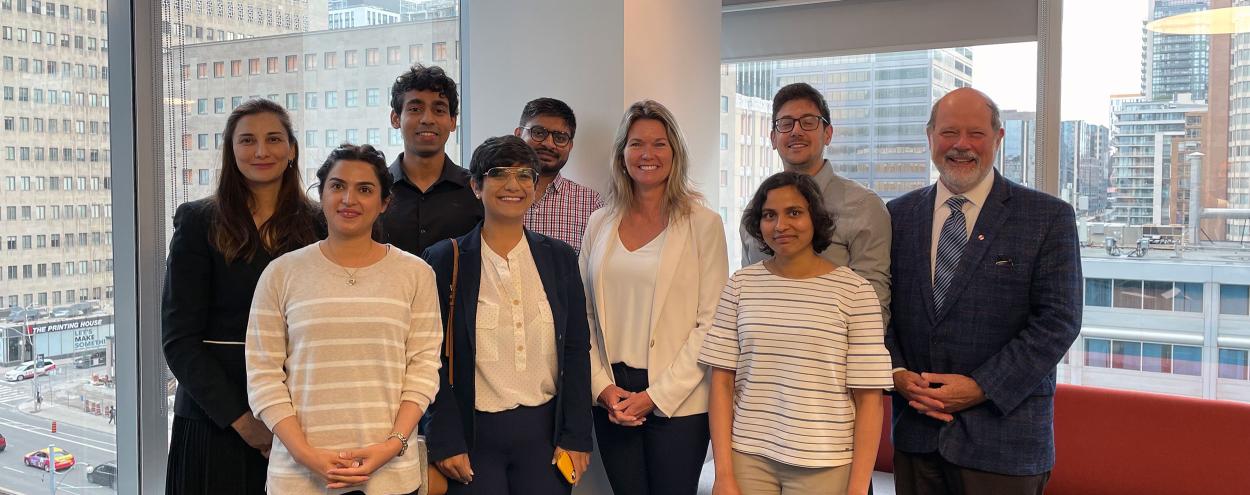
A George Brown College student sat down with Ontario’s Minister of Colleges and Universities to talk about how he helped develop a solution to a real-world business challenge during an internship provided by Mitacs, an organization that connects students and industry.
During his work placement in the Applied AI Solutions Development program at the School of Computer Technology, Shem Freddy Pereira (pictured, back row-second from the left) worked with Ottawa-based AI Quest. The industry project aimed to reduce adverse drug reactions among Canadian senior citizens by developing an automated solution for doctors and pharmacists.
"Current tools being used aren't always up to date, don't incorporate a lot of important metrics that should be used, and a lot of the processes are also done manually. We're trying to automate that and use machine learning as well to develop analytical insights and give better predictions,” Pereira said, noting his work involved a lot of market and product research.
"My knowledge has widened tremendously."
Pereira met with Ontario’s Minister of Colleges and Universities Jill Dunlop on September 13 at a Mitacs roundtable event in downtown Toronto. Mitacs CEO John Hepburn and five other post-secondary students also attended. Mitacs receives funding from the federal and Ontario governments to provide innovative research and problem-solving opportunities that pair students and recent graduates with businesses looking for help in overcoming specific challenges.
Industry opportunities for GBC students
George Brown started working with Mitacs in 2020. Ryan Billinger, Program Manager at the Office of Research and Innovation, who oversees GBC Mitacs projects, said the college has worked on 21 projects so far with more ready to go. Mitacs internships are paid and generally last four to six months.
“Our Mitacs partnerships are very important because they give students the experience of working in industry with some compensation,” he said. “Some companies continue to work with these students and train them in the workplace. In quite a few of our projects, the industry partner hires the students once the Mitacs project ends.”
real-world experience
Fiza Kaynat, a recent graduate of the Health Informatics program (postgraduate), worked on a Mitacs project with digital health care company Lumeca Health providing stakeholder analysis and implementation support this past spring and summer.
“The supportive and responsive team at Lumeca helped me perform to the best of my capabilities,” she said. “Daily stand-up meetings with my supervisor helped clarify concepts, provided the opportunity to ask questions and to discuss roadblocks, if any. The team was welcoming to my feedbacks and questions.”
Kaynat says she had a great experience and moved directly into a job with the Scarborough Health Network after her internship.
Are you interested in a Mitacs work-integrated learning experience? Ask your professors or program coordinator about upcoming opportunities.
Related
Recent Mitacs projects at GBC
EmersonGrow
EmersonGrow aims to transform the user experience of LED grow lights toward an integrated digital solar system. They have partnered with GBC to identify individual and customized grow light configurations suitable for each plant for successful plant growth. This project aims at allowing the user to choose the light recipe for their plants.
Lumeca Health
Founded in 2016, Lumeca Health's mission has been to serve one purpose: improve digital accessibility to health care for Canadians to improve Canadians' health. Since the pandemic began in 2020, Lumeca has been pivoting and innovating in order to fulfill market demand for specific use cases of virtual care.
Quantum Robotic Systems
Quantum Robotic Systems Inc. (QRS) is a Toronto-based company that has developed and patented a novel stair-climbing technology that allows users to carry heavy, bulky loads up and down stairs in an easier, faster, and safer way. The primary goal for this project is to improve upon QRS’s existing Control App to enhance its capabilities and its ease of use.
